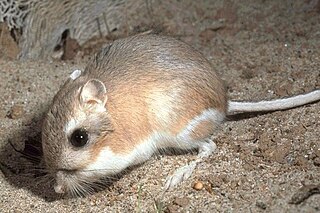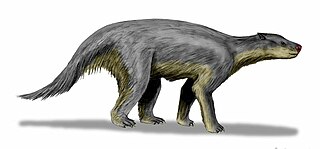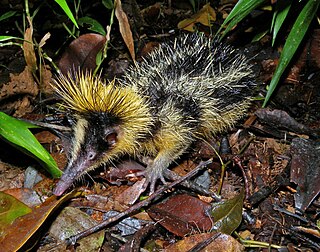 W
WAnomaluromorpha is a clade that unites the anomalures with the springhares. It has alternately been designated as either a suborder or infraorder. Most recently, Carleton & Musser 2005 recognized it as one of five suborders of rodents.
 W
WCastorimorpha is the suborder of rodents containing the beavers and the kangaroo rats. A 2017 study using retroposon markers indicated that they are most closely related to the Anomaluromorpha and Myomorpha.
 W
WElephantiformes is a suborder within the order Proboscidea that contains the elephants as well as their extinct relatives.
 W
WCarnivora is an order of placental mammals that have specialized in primarily eating flesh. Its members are formally referred to as carnivorans, though some species are omnivorous, such as raccoons and bears, and quite a few species such as pandas are specialized herbivores. The word 'carnivore' is derived from Latin carō "flesh" and vorāre "to devour", it refers to any meat-eating organism. The order Carnivora is the fifth largest order of mammals and one of the more successful members of the group; it comprises at least 279 species living on every major landmass and in a variety of habitats, ranging the cold polar regions to the hyper-arid region of the Sahara Desert to the open seas. They come in a huge array of different body plans in contrasting shapes and sizes. The smallest carnivoran is the least weasel with a body length of about 11 cm (4.3 in) and a weight of about 25 g (0.88 oz). The largest is the southern elephant seal, with adult males weighing up to 5,000 kg (11,000 lb) and measuring up to 6.7 m (22 ft). All species of carnivorans are descended from a group of mammals which were related to today's pangolins, having appeared in North America 6 million years after the Cretaceous–Paleogene extinction event. These early ancestors of carnivorans would have resembled small weasel or genet-like mammals, occupying a nocturnal shift on the forest floor or in the trees, as other groups of mammals like the mesonychians and creodonts were occupying the top faunivorous niche. However, by the time Miocene epoch appeared, most if not all of the major lineages and families of carnivorans had diversified and took over this niche.
 W
WThe term Hystricomorpha has had many definitions throughout its history. In the broadest sense, it refers to any rodent with a hystricomorphous zygomasseteric system. This includes the Hystricognathi, Ctenodactylidae, Anomaluridae, and Pedetidae. Molecular and morphological results suggest the inclusion of the Anomaluridae and Pedetidae in Hystricomorpha may be suspect. Based on Carleton & Musser 2005, these two families are treated here as representing a distinct suborder Anomaluromorpha.
 W
WMegabats constitute the family Pteropodidae of the order Chiroptera (bats). They are also called fruit bats, Old World fruit bats, or—especially the genera Acerodon and Pteropus—flying foxes. They are the only member of the superfamily Pteropodoidea, which is one of two superfamilies in the suborder Yinpterochiroptera. Internal divisions of Pteropodidae have varied since subfamilies were first proposed in 1917. From three subfamilies in the 1917 classification, six are now recognized, along with various tribes. As of 2018, 197 species of megabat had been described.
 W
WMicrobats constitute the suborder Microchiroptera within the order Chiroptera (bats). Bats have long been differentiated into Megachiroptera (megabats) and Microchiroptera, based on their size, the use of echolocation by the Microchiroptera and other features; molecular evidence suggests a somewhat different subdivision, as the microbats have been shown to be a paraphyletic group.
 W
WThe suborder Myomorpha contains 1,137 species of mouse-like rodents, nearly a quarter of all mammal species. Included are mice, rats, gerbils, hamsters, lemmings, and voles. They are grouped according to the structure of their jaws and molar teeth. They are characterized by their myomorphous zygomasseteric system, which means that both their medial and lateral masseter muscles are displaced forward, making them adept at gnawing. As in the hystricognathous rodents, the medial masseter muscle goes through the eye socket, a feature unique among mammals. Myomorphs are found worldwide in almost all land habitats. They are usually nocturnal seed-eaters.
 W
WNotioprogonia is a suborder of the extinct mammalian order Notoungulata and includes two families, Henricosborniidae and Notostylopidae.
 W
WPantodonta is an extinct suborder of eutherian mammals. These herbivorous mammals were one of the first groups of large mammals to evolve after the end of the Cretaceous. The last Pantodonts died out at the end of the Eocene.
 W
WPlesielephantiformes is an extinct suborder of large herbivorous mammals that were closely related to elephants.
 W
WSciurognathi is a suborder of rodents that includes squirrels, chipmunks, beavers, and many types of mice. The group is characterized by a specific shape to the lower jaw. In sciurognaths, the angular process of the jaw is in the same plane as the root of the incisors. This is in contrast to the suborder Hystricognathi where the angular process is outside the plane formed at the root of the incisor due to the presence of a shelf for muscle attachment.
 W
WSciuromorpha ("squirrel-like") is a rodent clade that includes several different rodent families. It includes all members of the Sciuridae as well as the mountain beaver species.
 W
WStrepsirrhini or Strepsirhini is a suborder of primates that includes the lemuriform primates, which consist of the lemurs of Madagascar, galagos ("bushbabies") and pottos from Africa, and the lorises from India and southeast Asia. Collectively they are referred to as strepsirrhines. Also belonging to the suborder are the extinct adapiform primates that thrived during the Eocene in Europe, North America, and Asia, but disappeared from most of the Northern Hemisphere as the climate cooled. Adapiforms are sometimes referred to as being "lemur-like", although the diversity of both lemurs and adapiforms does not support this comparison.
 W
WTenrecomorpha is the suborder of otter shrews and tenrecs, a group of afrotherian mammals indigenous to equatorial Africa and Madagascar, respectively. The two families are thought to have split about 47–53 million years ago. Potamogalid otter shrews were formerly considered a subfamily of Tenrecidae. The suborder is also presumed to contain the extinct genus Plesiorycteropus, a group of possibly fossorial insectivores similar to aardvarks, which is known to be more closely related to tenrecs of subfamily Tenrecinae than to golden moles of suborder Chrysochloridea.
 W
WTypotheria is a suborder of the extinct mammalian order Notoungulata and includes five families: Archaeopithecidae, Campanorcidae, Interatheriidae, Mesotheriidae, and Oldfieldthomasiidae. Cifelli indicated that Typotheria would be paraphyletic if it excluded members of the suborder Hegetotheria and he advocated inclusion of the hegetothere families Archaeohyracidae and Hegetotheriidae in Typotheria.
 W
WYangochiroptera, or Vespertilioniformes, is a suborder of Chiroptera that includes most of the microbat families, except the Rhinopomatidae, Rhinolophidae, Hipposideridae, and Megadermatidae. These other families, plus the megabats, are seen as part of another suborder, the Yinpterochiroptera.
 W
WThe Yinpterochiroptera is a suborder of the Chiroptera, which includes taxa formerly known as megabats and five of the microbat families: Rhinopomatidae, Rhinolophidae, Hipposideridae, Craseonycteridae, and Megadermatidae. This suborder is primarily based on molecular genetics data. This proposal challenged the traditional view that megabats and microbats form monophyletic groups of bats. Further studies are being conducted, using both molecular and morphological cladistic methodology, to assess its merit.